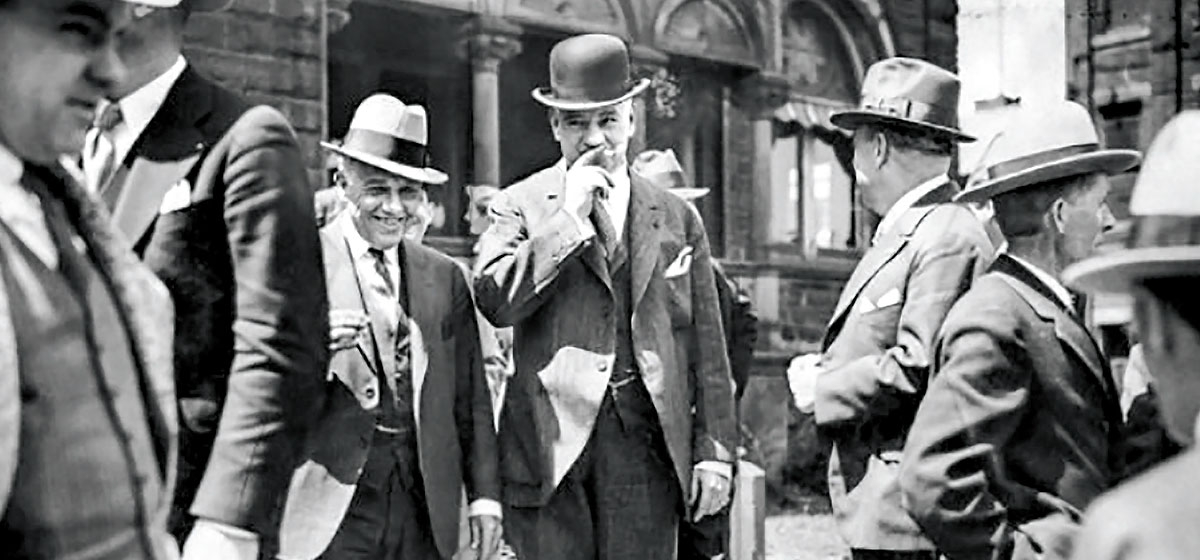The Bad Old Days

You won’t get depressed by reading Richard Gazarik’s “Wicked Pittsburgh.” The retired Tribune-Review reporter does not seek to darken the name of our fair city. He merely wants to gather, in one handy and readable volume, key stories of corruption, crime and skulduggery stretching back to the turn of the 20th century. The cumulative effect is tonic. You’ll gain a healthy perspective on the city, knowing that we have survived decades of perfidy. Besides, some of these bad guys were colorful characters.
Take Roxie Long, “Pittsburgh’s most arrested criminal.” His heyday was the 1920s and 1930s, “when Pittsburgh was a wide-open city rife with gambling, bootlegging, prostitution, corrupt police and politicians and gangland murders.” Roxie (whose real name was Rocco DiPippa) started as a petty if prolific thief and graduated to bootlegger, hijacker, counterfeiter, blackmailer and more. In 1922, on the run from the law, he hopped a ship to Italy but was intercepted in Cherbourg, France, by a Pittsburgh officer on his tail. Upon return, Roxie was a greeted as a media celebrity. He promptly escaped from custody, lurked around town and taunted the coppers with a letter published in The Pittsburgh Press. The long arm finally caught up with Roxie Long in Wilkes-Barre, Pa., of all places. He served his time and then continued a fitful life of crime, dying at 87 in obscurity.
Gazarik assembles his stories with admirable economy and fidelity to the sources, as the lengthy bibliography shows. Handsome black-and-white photos pepper the text. He writes with the no-frills style of an old-school newspaper reporter and neither moralizes nor rationalizes. The voices of the day hold forth, from baroque local newspaper editorials to the crusading national journalist Walter Liggett in 1930: “It is very doubtful whether anywhere else in America there exists such debauched, dishonest or utterly incompetent public officials as those comprising the political machine which mismanages the affairs and systematically loots the treasuries of Pittsburgh and Allegheny County.”
To be fair, Pittsburgh had lots of company in big-city corruption of the era. Prohibition had turned most everyone into criminals at some level. The numbers racket flourished because most people thought it was a minor vice. The parallel economy ensnared law enforcement; “bookies understood that they would have to stand a few raids to make the police look good” in the eyes of civic reformers. Mayor David Lawrence, a hero in the historical record for unpolluting the city, “regarded vice as a fact of life” and “tolerated the rackets as part of the price of running a big city.” Moreover, Gus Greenlee and William “Woogie” Harris made illegal fortunes running numbers but became “economic pillars of the Hill District” in legit ways.
Gazarik fairly de-
scribes the machinations that got Pittsburgh built starting in the late 19th century. Booth & Flinn Ltd. “played a role in nearly every major building project” by exerting raw power through the patronage of political boss Christopher Lyman Magee and his cousin, the city planning director Edward Manning Bigelow. Bigelow “wrote bid specifications in a way that awarded contracts based on ‘lowest responsible bidder.’ Booth & Flinn were always found to be the most responsible.”
Along the way, we learn the origin story of Pittsburgh’s potholes. Booth & Flinn had the inside track on cobblestone, and later asphalt. “Pittsburgh reformer Oliver McClintock charged that Booth & Flinn ‘did abominable work while charging outrageous prices’ for paving streets.” When Gov. John Tener came to town, “he was appalled. … ‘The ruts and holes are a disgrace to a great city like Pittsburg’ ” (which had shed its “h” at the time). The names of Magee and Bigelow are among the city’s esteemed, adorning a great hospital and a central boulevard. No one ever said politics was pretty.
Not every chapter in “Wicked Pittsburgh” is about lawbreakers or benders. The story of Mayor William McNair, “the clown prince of Pittsburgh politics” who served from 1933 through 1936, is rousing entertainment. The first Democrat after 28 years of GOP control, he was a Mennonite who embraced the New Deal policies of Roosevelt, but turned out to be “impulsive and erratic.” After inauguration, he “placed his desk in the lobby of city hall and, for a time, held court while an orchestra played music as he worked.” A media hog given to stunts and gnomic statements, he created a reign of chaos. Though praised for his honesty, “his friends and foes will agree he should never have been mayor,” the Post-Gazette wrote.
Though I have lived on the North Side for two decades, I didn’t know half the stories that Gazarik collected about the infamous days of my neighborhood when it was Allegheny City, before its 1907 annexation by Pittsburgh. The area now called the North Shore was, back in the day, known as “Little Canada,” a “rough-and-tumble place filled with brothels, speakeasies and saloons.” It harbored all manner of bad guys “provided they followed the unwritten rule of ‘leave Allegheny alone’ and committed their crimes elsewhere.” Hence, “a crook was as safe in Little Canada as if he were in its namesake to the north.”
Nettie Gordon was one of the grand madames of this northern realm, overseeing a 20-block section of brothels. She “outfitted her prostitutes in fine clothes purchased from Boggs & Buhl,” the upscale department store, and “had the police in her pocket” and stayed safe with ties to the ruling Republican Party machine. On her deathbed in 1934, a kind soul asked if she wanted a minister to visit, “but she just smiled and said she had lived without God and would die without him.”
“Wicked Pittsburgh,” at 143 pages, may have left out your favorite scandal or scallywag. But it won’t leave you pining for the good old days.





